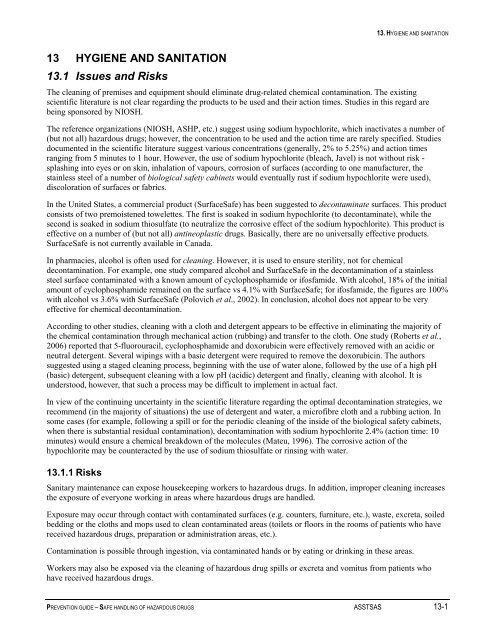Prevention Guide - Safe Handling of Hazardous Drugs - Irsst
Prevention Guide - Safe Handling of Hazardous Drugs - Irsst
Prevention Guide - Safe Handling of Hazardous Drugs - Irsst
Create successful ePaper yourself
Turn your PDF publications into a flip-book with our unique Google optimized e-Paper software.
13. HYGIENE AND SANITATION<br />
13 HYGIENE AND SANITATION<br />
13.1 Issues and Risks<br />
The cleaning <strong>of</strong> premises and equipment should eliminate drug-related chemical contamination. The existing<br />
scientific literature is not clear regarding the products to be used and their action times. Studies in this regard are<br />
being sponsored by NIOSH.<br />
The reference organizations (NIOSH, ASHP, etc.) suggest using sodium hypochlorite, which inactivates a number <strong>of</strong><br />
(but not all) hazardous drugs; however, the concentration to be used and the action time are rarely specified. Studies<br />
documented in the scientific literature suggest various concentrations (generally, 2% to 5.25%) and action times<br />
ranging from 5 minutes to 1 hour. However, the use <strong>of</strong> sodium hypochlorite (bleach, Javel) is not without risk -<br />
splashing into eyes or on skin, inhalation <strong>of</strong> vapours, corrosion <strong>of</strong> surfaces (according to one manufacturer, the<br />
stainless steel <strong>of</strong> a number <strong>of</strong> biological safety cabinets would eventually rust if sodium hypochlorite were used),<br />
discoloration <strong>of</strong> surfaces or fabrics.<br />
In the United States, a commercial product (Surface<strong>Safe</strong>) has been suggested to decontaminate surfaces. This product<br />
consists <strong>of</strong> two premoistened towelettes. The first is soaked in sodium hypochlorite (to decontaminate), while the<br />
second is soaked in sodium thiosulfate (to neutralize the corrosive effect <strong>of</strong> the sodium hypochlorite). This product is<br />
effective on a number <strong>of</strong> (but not all) antineoplastic drugs. Basically, there are no universally effective products.<br />
Surface<strong>Safe</strong> is not currently available in Canada.<br />
In pharmacies, alcohol is <strong>of</strong>ten used for cleaning. However, it is used to ensure sterility, not for chemical<br />
decontamination. For example, one study compared alcohol and Surface<strong>Safe</strong> in the decontamination <strong>of</strong> a stainless<br />
steel surface contaminated with a known amount <strong>of</strong> cyclophosphamide or ifosfamide. With alcohol, 18% <strong>of</strong> the initial<br />
amount <strong>of</strong> cyclophosphamide remained on the surface vs 4.1% with Surface<strong>Safe</strong>; for ifosfamide, the figures are 100%<br />
with alcohol vs 3.6% with Surface<strong>Safe</strong> (Polovich et al., 2002). In conclusion, alcohol does not appear to be very<br />
effective for chemical decontamination.<br />
According to other studies, cleaning with a cloth and detergent appears to be effective in eliminating the majority <strong>of</strong><br />
the chemical contamination through mechanical action (rubbing) and transfer to the cloth. One study (Roberts et al.,<br />
2006) reported that 5-fluorouracil, cyclophosphamide and doxorubicin were effectively removed with an acidic or<br />
neutral detergent. Several wipings with a basic detergent were required to remove the doxorubicin. The authors<br />
suggested using a staged cleaning process, beginning with the use <strong>of</strong> water alone, followed by the use <strong>of</strong> a high pH<br />
(basic) detergent, subsequent cleaning with a low pH (acidic) detergent and finally, cleaning with alcohol. It is<br />
understood, however, that such a process may be difficult to implement in actual fact.<br />
In view <strong>of</strong> the continuing uncertainty in the scientific literature regarding the optimal decontamination strategies, we<br />
recommend (in the majority <strong>of</strong> situations) the use <strong>of</strong> detergent and water, a micr<strong>of</strong>ibre cloth and a rubbing action. In<br />
some cases (for example, following a spill or for the periodic cleaning <strong>of</strong> the inside <strong>of</strong> the biological safety cabinets,<br />
when there is substantial residual contamination), decontamination with sodium hypochlorite 2.4% (action time: 10<br />
minutes) would ensure a chemical breakdown <strong>of</strong> the molecules (Mateu, 1996). The corrosive action <strong>of</strong> the<br />
hypochlorite may be counteracted by the use <strong>of</strong> sodium thiosulfate or rinsing with water.<br />
13.1.1 Risks<br />
Sanitary maintenance can expose housekeeping workers to hazardous drugs. In addition, improper cleaning increases<br />
the exposure <strong>of</strong> everyone working in areas where hazardous drugs are handled.<br />
Exposure may occur through contact with contaminated surfaces (e.g. counters, furniture, etc.), waste, excreta, soiled<br />
bedding or the cloths and mops used to clean contaminated areas (toilets or floors in the rooms <strong>of</strong> patients who have<br />
received hazardous drugs, preparation or administration areas, etc.).<br />
Contamination is possible through ingestion, via contaminated hands or by eating or drinking in these areas.<br />
Workers may also be exposed via the cleaning <strong>of</strong> hazardous drug spills or excreta and vomitus from patients who<br />
have received hazardous drugs.<br />
PREVENTION GUIDE – SAFE HANDLING OF HAZARDOUS DRUGS ASSTSAS 13-1

















